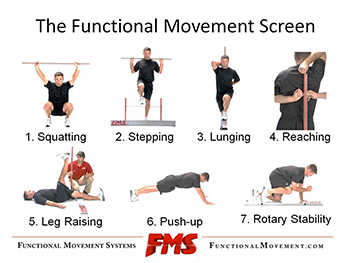Functional Movement Screen (FMS)
Original Editor - Adriana Mesa
Top Contributors - Naomi O'Reilly, Adriana Mesa, Admin, Evan Thomas, Kim Jackson, Tony Lowe, Wanda van Niekerk, Amanda Ager, Simisola Ajeyalemi, Jess Bell, Robin Tacchetti, 127.0.0.1, Scott Buxton, Mariam Hashem and WikiSysop
Objective[edit | edit source]
The Functional Movement Screen (FMS) if a tool developed by Cook and colleagues in 1997[1] to help clinicians and health care professions screen individuals for risk of injury and / or a dysfunctional or performance-limiting movement pattern. The FMS was first presented commercially as a manual for screening athletes and the product line was later expanded to include a range of equipment for performing the screen, certifications for those screening athletes, seminars, books, and videos.[2]
The FMS is a tool used to identify asymmetries which result in functional movement deficiencies. The FMS aims to identify imbalances in mobility and stability during seven fundamental movement patterns. These movement patterns are designed to provide observable performance of basic locomotor, manipulative and stabilizing movements by placing an individual in extreme positions where weaknesses and imbalances become noticeable if appropriate mobility and motor control is not utilized. Once these deficiencies have been identified through the FMS, a program of corrective exercises is then developed with the goal of preventing musculoskeletal injuries.
The FMS consists of seven movement patterns which require mobility and stability. The seven following movement patterns are scored from 0-3 points, with the sum creating a score ranging from 0-21 points.
- Deep Squat
- Hurdle Step
- In-line Lunge
- Active Straight-leg Raise
- Trunk Stability Push-up
- Rotary Stability
- Shoulder Mobility
Intended Population[edit | edit source]
The FMS was intended to serve as a screen to identify individuals with functional movement deficits that could indicate an increased risk of injury. Use in the literature varies from young, active individuals to middle-aged individuals, elite, collegiate and professional athletes, as well as military and firefighters. A lower FMS scores have been noted to be associated with an increased BMI, increased age, and decreased activity level.[3]
Evidence[edit | edit source]
Reliability[edit | edit source]
Multiple studies have demonstrated excellent reliability of the FMS screen [4][5][6]. A recent study by Teyhen et al [4] revealed that among novice raters, the FMS demonstrated moderate to good inter-rater and intra-rater reliability, even with minimal training (4 hours). Moran et al found[7] ‘moderate’ evidence that raters can achieve acceptable levels of inter-rater and intra-rater reliability of composite FMS scores when using live ratings. In a different study the inter-rater reliability was found to be excellent [5][6].
Validity[edit | edit source]
A score of <=14 on the FMS is used as the cut-off score. Individuals who score less than 14 points on the FMS screen have greater odd for sustaining an injury [8]. Research to date is limited and it is not yet clear for which sports or professions the FMS is optimal in predicting injury risk, and whether the original cutoff score of <=14 is valid in different populations [4]. There is however, preliminary research by Kiesel et al [8] that suggests that NFL (National Football League) players who score <= 14 on the FMS had a positive likelihood ratio of 5.8 to sustain a time-loss injury. In addition to this Alemany et al[9] suggest that pain occurrence may be a stronger indicator of injury risk than a low composite score and provides a simpler method of evaluating injury risk compared to the full FMS.
FMS vs. SFMA[edit | edit source]
Many clinicians confuse the Functional Movement Screen tool with the Selective Functional Movement Assessment (SFMA). Both tools are a part of the same Functional Movement System created by Cook and colleagues, but their fundamental purposes are quite different. The SFMA is meant to be used in a diagnostic capacity, designed to identify musculoskeletal dysfunction among individuals affected by pain. Whereas the FMS is a screening tool, not intended for diagnosis. The FMS aims to identify imbalances in mobility and stability during functional movements.
Screening Tool[edit | edit source]
|
The same individuals who brought you the FMS, also have developed other helpful tools for clinicians and fitness professionals such as the SFMA, FCS, and the YBT.
- Selective Functional Movement Assessment (SFMA)
- Fundamental Capacity Screen (FCS)
- Y-Balance Test (YBT)
References[edit | edit source]
- ↑ Cook G, Burton L, Fields K, Kiesel K. The Functional Movement Screen. Danville, VA: Athletic Testing Services Inc, 1998.
- ↑ Beardsley C, & Contreras B, The functional movement screen: A review. Strength and Conditioning Journal. 2014; 36(5): 72-80.
- ↑ Mitchell UH, Johnson AW, Vehrs PR, Feland JB, & Hlton SC. Performance on the Functional Movement Screen in older active adults. J Sport & Health Science. 2016; 5(1): 119-125. Doi:[/doi.org/10.1016/j.jshs.2015.04.006 https://doi.org/10.1016/j.jshs.2015.04.006]
- ↑ 4.0 4.1 4.2 1. Teyhen DS, Shaffer SW, Lorenson CL, Halfpap JP, Donofry DF, Walker MJ, Dugan JL, Childs JD. The functional movement screen: A reliability study. JOSPT. 2012; 42:530-40.
- ↑ 5.0 5.1 2. Schneiders AG, Davidsson A, Horman E, Sullivan SJ. Functional movement screen normative values in a young, active population. IJSPT. 2011; 6: 75-82
- ↑ 6.0 6.1 3. Parenteau GE, Gaudreault N, Chambers S, Boisvert C, Grenier A, Gagne G, Balg F. Functional movement screen test: A reliable screening test for young elite ice hockey players. Phys There Sport. 2013.
- ↑ Moran RW, Schneiders AG, Major KM, Sullivan SJ. How reliable are Functional Movement Screening scores? A systematic review of rater reliability. British journal of sports medicine. 2016 May 1;50(9):527-36.
- ↑ 8.0 8.1 4. Kiesel K, Plisky PJ, Voight ML. Can serious injury in professional football be predicted by a preseason functional movement screen? N Am J Sports Phys There. 2007; 2:147-158.
- ↑ Alemany JA, Bushman TT, Grier T, Anderson MK, Canham-Chervak M, North WJ, Jones BH. Functional Movement Screen: Pain versus composite score and injury risk. Journal of science and medicine in sport. 2017 Nov 1;20:S40-4.







